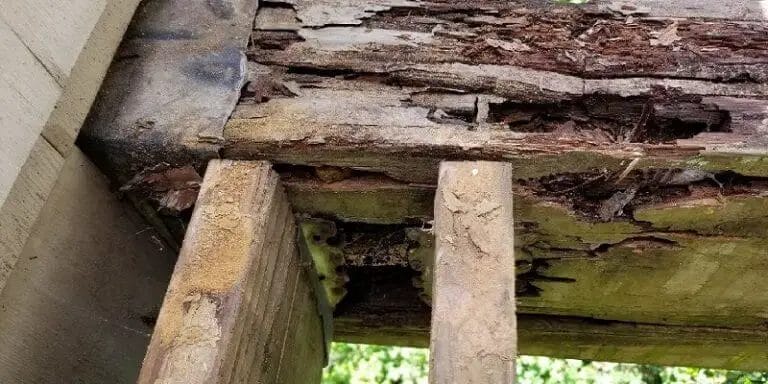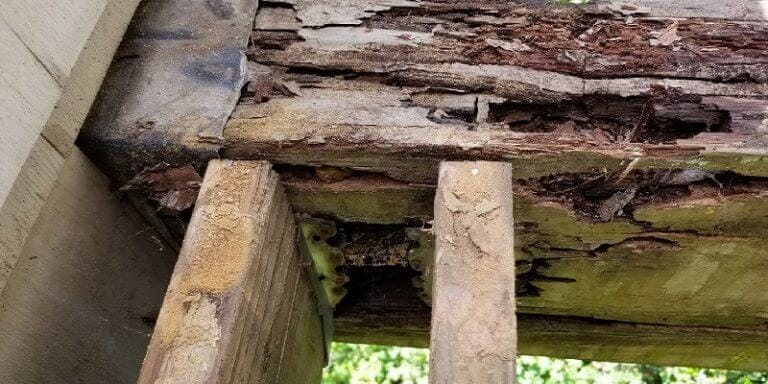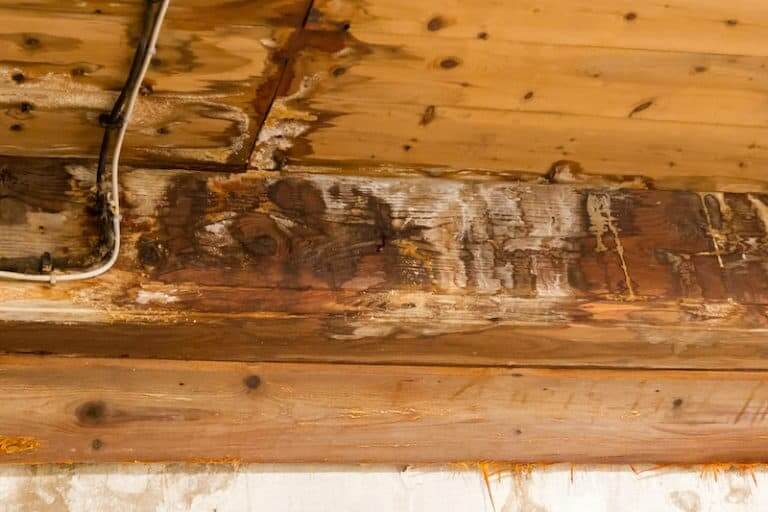Home insurance is designed to protect homeowners from unexpected damages and accidents. However, whether rotted wood is covered by home insurance depends on the specific policy and the cause of the rot. In general, most standard home insurance policies do not cover damage caused by wear and tear or maintenance issues, including rotted wood. However, if the rot is the result of a covered peril, such as a storm or a burst pipe, it may be covered. It’s important to review your policy carefully and consult with your insurance provider to understand the extent of coverage for rotted wood.

Factors that Determine if Home Insurance Covers Rotted Wood
Home insurance is designed to protect homeowners from financial losses due to property damage or loss caused by covered perils. However, not all types of damage are covered by home insurance policies, and one such issue is rotted wood. Whether home insurance covers the cost of repairs or replacement for rotted wood depends on several factors. In this section, we will explore these factors in detail.

1. Cause of the Rotted Wood
The cause of the rotted wood is a significant factor in determining whether home insurance will cover it. Generally, home insurance policies cover damage caused by sudden and accidental events, such as storms, fire, or vandalism. If the rotted wood is a result of an insured peril, such as a tree falling on the house during a storm, the insurance company may cover the cost of repairs or replacement.
However, if the rotted wood is a result of neglect, lack of maintenance, or gradual deterioration over time, it is unlikely that home insurance will cover it. Insurance companies typically view rotted wood as a maintenance issue that homeowners are responsible for addressing on their own.
2. Policy Coverage and Exclusions
The coverage and exclusions in your home insurance policy play a crucial role in determining whether rotted wood is covered. It’s essential to review your policy documents carefully and understand the specific coverage provided. Some policies may explicitly exclude rot or decay from the list of covered perils.
If your policy includes language that excludes rot or decay, then any damage or repairs related to rotted wood will not be covered. However, if the policy does not have such exclusions or includes coverage for hidden or gradual damage, it may be possible to file a claim for rotted wood.
3. Dwelling Age and Maintenance
The age of your dwelling and the level of maintenance it has received could affect the coverage for rotted wood. Older homes or properties that have not been adequately maintained are more susceptible to wood rot. Insurance companies may consider the age and maintenance of the dwelling when assessing a claim for rotted wood.
If your home is older or shows signs of neglect, the insurance company may argue that the damage was preventable with proper maintenance and deny coverage. On the other hand, if you can demonstrate that you have proactively maintained your home and the rotted wood is a result of an insured peril, you may have a better chance of a successful claim.
4. Additional Endorsements or Riders
Some homeowners may opt to add endorsements or riders to their home insurance policies to cover specific perils or damages not covered in the standard policy. If you have added an endorsement for wood rot or hidden damage, it is more likely that your insurance company will cover the costs associated with rotted wood.
However, it’s important to note that adding endorsements or riders often comes with additional premiums or deductibles. It’s advisable to consult with your insurance provider to understand the terms and conditions of any endorsements related to rotted wood.
Summary
While home insurance may cover certain types of property damage, such as fire or storm-related damage, rotted wood is not always included. The coverage for rotted wood depends on various factors, including the cause of the damage, the policy coverage and exclusions, the age and maintenance of the dwelling, and any additional endorsements or riders. It’s crucial to review your policy documents and consult with your insurance provider to understand the specific coverage provided for rotted wood.

Steps to Take if Rotted Wood is Covered by Home Insurance
Discovering rotted wood in your home can be a concerning issue. Not only does it affect the structural integrity of your property, but it can also lead to other problems like mold and infestations. Luckily, if you have home insurance, there is a possibility that it may cover the cost of repairing or replacing the rotted wood. To ensure a smooth claims process, here are the steps you should take if rotted wood is covered by your home insurance.
1. Review your insurance policy
The first step is to carefully review your home insurance policy to determine if it covers rotted wood. Look for specific clauses or provisions that mention coverage for wood damage caused by rot or decay. It’s important to understand the terms and conditions of your policy to know what is covered and what is excluded.
2. Document the damage
Before filing a claim, document the extent of the rotted wood damage in your property. Take clear and detailed photographs or videos that clearly show the affected areas. This evidence will help support your claim and provide proof of the damage to your insurance company.
3. Contact your insurance company
Once you have reviewed your policy and gathered the necessary documentation, contact your insurance company to initiate the claims process. It is essential to notify them as soon as possible to avoid any delays or complications. Provide them with a detailed description of the rotted wood damage and the evidence you have collected.
4. Schedule an inspection
Your insurance company may require an inspection of the rotted wood damage by a professional. They may send their own adjuster to assess the situation or request that you hire a licensed contractor. Cooperate with their requirements and schedule the inspection promptly.
5. Obtain repair estimates
It is advisable to obtain repair estimates from reputable contractors to determine the cost of repairing or replacing the rotted wood. Make sure the estimates are detailed and include all necessary materials and labor. Keep copies of these estimates as they will be essential during the claims process.
6. File the insurance claim
After the inspection and obtaining repair estimates, file the insurance claim with your insurance company. Complete any necessary forms or provide any additional information they may require. Be prepared to provide copies of your documentation, including photographs, videos, and repair estimates.
7. Follow up on the claim
Stay in regular contact with your insurance company to ensure the progress of your claim. Follow up on any additional information or documentation they may need. It is essential to keep a record of all communication with your insurance company, including dates, times, and names of representatives.
8. Review the settlement
Once your claim is processed, carefully review the settlement offer provided by your insurance company. Ensure that it covers the cost of repairing or replacing the rotted wood damage adequately. If you have any questions or concerns, discuss them with your insurance company before accepting the settlement.
9. Make the repairs
If you have accepted the settlement offer, proceed with making the necessary repairs to address the rotted wood damage. Hire a professional contractor to ensure the work is done correctly and meets the requirements set by your insurance company. Keep all receipts and documentation related to the repairs for future reference.
10. Prevent future damage
After the repairs are completed, take steps to prevent future rotted wood damage. Regularly inspect and maintain your property to identify and address any signs of decay or rot early on. This may include implementing proper ventilation, sealing any gaps or cracks, and promptly addressing any water leaks or moisture issues.
In summary, if you discover rotted wood in your home and it is covered by your home insurance, it is crucial to follow the necessary steps to file a claim and ensure a smooth process. Review your insurance policy, document the damage, contact your insurance company, schedule an inspection, obtain repair estimates, file the claim, follow up on the claim, review the settlement offer, make the repairs, and take preventive measures for the future. By following these steps, you can address the rotted wood issue and restore the integrity of your home.

Alternatives to Home Insurance for Rotted Wood Repair
If you have discovered rotted wood in your home, it’s important to address the issue promptly to prevent further damage. While home insurance may cover some types of repairs, it’s not always the best option or may not be available to everyone. In this section, we will explore some alternatives to home insurance for rotted wood repair.
1. DIY Repair
If you have the necessary skills and tools, you may consider repairing the rotted wood yourself. DIY repairs can be a cost-effective option, especially for smaller areas of damage. However, it’s important to assess the extent of the damage and your own capabilities before attempting this route. Improper repairs can lead to further damage or even compromise the structural integrity of your home.
2. Hiring a Handyman
If you’re not confident in your DIY skills or the repairs required are more complex, hiring a handyman can be a viable alternative. Handyman services are often more affordable than hiring a specialized contractor. However, it’s crucial to choose a reputable and experienced handyman to ensure quality workmanship.
3. Hiring a General Contractor
For extensive rotted wood repairs or if the damage is affecting the structural integrity of your home, hiring a general contractor is a recommended option. General contractors have the expertise and resources to handle large-scale repairs and ensure the job is done correctly. While this option may be more expensive, it provides peace of mind knowing that professionals are handling the repair.
4. Home Repair Grants and Loans
In some cases, financial assistance may be available through home repair grants or loans. These programs are often provided by local government agencies or non-profit organizations and aim to help homeowners with limited resources address essential repairs. Eligibility criteria and application processes vary, so it’s important to research and inquire about available programs in your area.
5. Financing Options
If you’re unable to cover the cost of rotted wood repair upfront, financing options such as personal loans or home improvement loans can help spread out the expense over time. It’s important to carefully consider the terms and interest rates associated with these financing options before committing.
6. Prevention and Maintenance
The best way to avoid costly rotted wood repairs in the future is through prevention and regular maintenance. This includes inspecting and addressing any signs of water damage, ensuring proper ventilation, and promptly repairing any minor wood damage. By taking proactive measures, you can potentially avoid the need for extensive repairs and the associated costs.
In summary, while home insurance may cover certain types of rotted wood repair, there are several alternatives available for homeowners who don’t have insurance or prefer not to rely on it. Whether you choose to tackle the repair yourself, hire a handyman or general contractor, seek financial assistance, or invest in prevention and maintenance, addressing rotted wood promptly is essential to protect the integrity and value of your home.
Tips for Preventing Rotted Wood and Avoiding Home Insurance Claims
Rotted wood can be a common issue in many homes, especially in areas with high humidity or frequent rain. Not only does it compromise the structural integrity of your home, but it can also lead to costly repairs and even home insurance claims. To prevent rotted wood and avoid these potential headaches, consider the following tips:
1. Regularly inspect and maintain your home
One of the key ways to prevent rotted wood is to regularly inspect your home for any signs of damage or deterioration. Take the time to walk around your property and check for any areas with peeling paint, cracked caulking, or damaged wood. Promptly address any issues and make necessary repairs to prevent further damage.
2. Ensure proper drainage
Poor drainage can contribute to the rotting of wood. Make sure that your gutters and downspouts are clean and free of debris to allow for proper water flow. Additionally, ensure that the ground around your home is graded away from the foundation to prevent water from pooling near the base of your house.
3. Maintain proper ventilation
Proper ventilation is crucial in preventing moisture buildup, which can lead to rotted wood. Ensure that your attic, crawl spaces, and other enclosed areas are well-ventilated. Consider installing vents or fans if necessary to promote air circulation and reduce humidity levels.
4. Protect vulnerable areas
Areas of your home that are particularly susceptible to moisture, such as windows, doors, and decks, should receive extra attention. Apply a waterproof sealant or paint to protect these areas from water infiltration. Regularly check and repair any damaged or worn-out seals.
5. Address plumbing leaks promptly
Plumbing leaks can result in water damage and contribute to the rotting of wood. If you notice any signs of a leak, such as dampness or water stains, address it immediately. Repair the leak and ensure that the affected area is properly dried and treated to prevent further damage.
6. Use treated or rot-resistant wood
When undertaking construction or renovation projects, opt for treated or rot-resistant wood. These types of wood are specially treated to resist moisture and decay, making them less prone to rotting. While they may be slightly more expensive initially, they can save you money in the long run by avoiding costly repairs.
7. Maintain a safe distance between wood and soil
Direct contact between wood and soil can accelerate rotting. Ensure that there is a safe distance between the ground and any wooden structures, such as fences or posts. Use concrete footings or other suitable materials to elevate the wood and prevent moisture absorption from the soil.
8. Consider professional inspections
For a thorough assessment of your home’s condition and to identify any potential issues, consider hiring a professional inspector. They can provide expert advice and recommendations for preventing rotted wood and other problems. Regular inspections can catch small issues before they become major concerns.
In summary, preventing rotted wood is essential for maintaining the integrity of your home and avoiding costly home insurance claims. By regularly inspecting your home, ensuring proper drainage and ventilation, protecting vulnerable areas, addressing plumbing leaks, using treated wood, maintaining a safe distance from soil, and considering professional inspections, you can significantly reduce the risk of rotted wood and its associated problems.
FAQs
Does home insurance cover rotted wood?
Typically, home insurance does not cover damage caused by rot, as it is considered a result of poor maintenance. However, if the rotted wood was a result of a covered peril, such as a sudden and accidental water leak, it may be covered. It’s best to check your policy or speak with your insurance provider for specific details.
Conclusion:
In conclusion, while home insurance provides coverage for many types of damage, including water damage and structural issues, it is important to understand that every policy is different. When it comes to rotted wood, coverage can vary depending on the cause and extent of the damage. It is recommended to review your insurance policy and consult with your insurance provider to determine if rotted wood is covered. Additionally, taking preventative measures such as regular maintenance and addressing any signs of rot promptly can help avoid costly repairs and potential coverage issues.
Remember: Always refer to your insurance policy and consult with your insurance provider for accurate and personalized information regarding coverage.